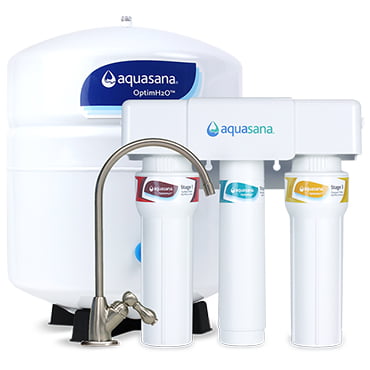Does Reverse Osmosis Remove Chlorine from Water?
Written by: Gene Fitzgerald // Last Updated: Dec 28, 2022
This page may contain affiliate links. If you buy a product or service through such a link we earn a commission at no extra cost to you. Learn more.
While chlorination of water has been a blessing for preventing waterborne illnesses, it doesn’t leave a delightful smell or taste in the water.
Some studies are also emerging, questioning the long-term effects of drinking chlorinated water, and for these reasons, people many want to find a way to filter it out.
Can reverse osmosis help you with this? Does reverse osmosis remove chlorine from water? Let’s find out!
Key Takeaways
- Most RO filtration systems will effectively remove chlorine from your water; however, the pre-filters do this, not the reverse osmosis process itself.
- Carbon pre-filters react chemically with chlorine to remove it before it reaches the RO membrane. If the chlorine does reach the membrane, it can actually cause damage.
- Most RO systems will remove a minimum of 95% chlorine from the water.
Does Reverse Osmosis Remove Chlorine from Water?
Reverse osmosis as a stand-alone process isn’t suitable for filtering chlorine and will only cause damage to the RO membrane.
Thankfully, most RO systems available for purchase have taken this into account and already have at least one pre-filtration step using carbon to eliminate the chlorine before it reaches the RO membrane.
So yes, a reverse osmosis system removes chlorine from water, but reverse osmosis alone doesn’t.
How Does Reverse Osmosis Work to Remove Chlorine?
Activated carbon pre-filters in a reverse osmosis system work to remove any residual chlorine from the water before it reaches the membrane. The carbon reacts chemically with chlorine to do this.
Aren’t RO Membranes Affected by Chlorine?
If you expose an RO membrane to chlorine, it will be affected. Chlorine causes oxidization of the mesh in the membrane, which makes its pores bigger and allows contaminants to get through. This is why the chlorine is removed by pre-filters before the water reaches the RO membrane in reverse osmosis systems.
How Much Chlorine Does RO Remove?
Depending on which system you opt for, they have varying levels of effectiveness for removing chlorine, though the majority will be above 95%.
The AquaTru water filter, which is a countertop RO system, filters 96.6% of chlorine, and the Aquasana OptimH2O under-sink RO system filters 97.66% (more details below).
The Leading RO Systems to Remove Chlorine
The #1 RO System for Chlorine: AquaTru
Alternatively: Aquasana OptimH2O
- 97.66% Average Chlorine Reduction
- Certified to Remove 80+ Contaminants
- NSF-Standards: 42, 53, 58, 401, and P473
- Remineralization Improves Water Taste
- Ready for DIY Install
- Easy to Maintain
- 90-Day Satisfaction Guarantee
What Else Does Reverse Osmosis Remove?
Reverse osmosis water filtration systems are capable of removing a huge range of contaminants from your water supply. They include;
- Chlorine and chloramine
- Lead
- Chromium
- Copper
- Cadmium
- Arsenic
- Fluoride
- Radium
- Sulfate
- Nitrate and nitrite
- Phosphorous
- Pesticides
- Pharmaceuticals
- Volatile organic compounds (VOCs)
Many of these are not removed with reverse osmosis alone, but require the added pre-filters found in an RO system. Utilizing different methods of filtration in one system allows the targeting of multiple contaminants. If we had just RO alone, without the pre-filters, it would not be able to remove;
- Chemicals like pesticides and herbicides
- Chlorine
- Chloramine
- Disinfection byproducts
- Hydrogen sulfide
Considerations When Buying an RO Water Filter
Reverse Osmosis Systems and NSF Certifications
When choosing your RO system, look for one that is NSF-certified or tested. This ensures that the system is made from high-quality materials and that the performance claimed by the manufacturer is ensured.
If you are particularly concerned about chlorine, NSF standard 42 tests for its reduction.
The Water Filtration Process
An RO system worth its salt usually has 4 or 5 stages of water filtration built in. The water will pass through all of these before it exits the dispenser. The stages may be;
- Sediment pre-filters to trap sediment.
- Granular carbon pre-filter to remove chlorine and other organic chemicals, as well as bad tastes and smells.
- Carbon block pre-filters (same contaminant removal as step 2).
- Reverse osmosis membrane, which eliminates all other remaining contaminants.
- Coconut shell post-filters to remove any residual tastes.
Some systems have a remineralization post-filter, which adds healthy minerals back into the water supply that have been removed during the RO process.
RO Filter Style
Countertop reverse osmosis water filters, under sink reverse osmosis filtration systems, and whole house RO filters are the three RO filter styles you can choose from. All are very similar performance-wise.
For private use, a whole house system probably isn’t necessary. The countertop units are installation free and easily portable, but if you use an under sink system, they will require a few possibly intrusive changes.
Water Demand
Be sure to check that the system you are buying can meet your water demand, whether that be that the system has a large enough storage tank or an adequate flow rate.
RO System Installation and Filter (Membrane) Replacements
Countertop systems connect to standard kitchen taps in 5 minutes or less. The under counter models require a little more work, which usually involves drilling a hole in your kitchen counter or sink for the RO faucet and drilling into the sink’s drain line for a drain connection.
Also, we recommend you go with a modular design system. In that case, when it’s time to replace the filter, you get rid of the whole housing too, which is excellent for preventing bacteria from accumulating and it only takes a few minutes. Still, it does mean filter replacements are a little more costly.
Water Pressure and Water Wastage
Water wastage is an unfortunate part of having an RO system, particularly if you have low water pressure. Some systems come with built-in pumps to help reduce wastage.
Cost
When factoring in cost, consider the availability and price of replacement filters and RO membranes, and don’t opt for a low-quality system to save a few bucks. In the long run, leaking and maintenance will end up being more costly.
Where to Buy
The best place to buy is online, as you are more likely to get the best prices and the most diverse product selections. As point-of-use RO systems are easy enough to use on your own, there is usually no need to consult a local water expert either.
Main Drawbacks of RO Water Purification
While RO water purification is one of the most effective methods out there, it does have a couple of potential drawbacks to consider.
Wastewater
For every one gallon of purified water you get out of a standard RO system, it will waste about 4 gallons. Unfortunately, it is just part of having an RO system; they all will create quite a bit of wastewater and cause your water bill to creep up.
Mineral Loss
When the water passes through the RO membrane, it removes most of the unhealthy contaminants and impurities in your water. Unfortunately, it also removes the good stuff, like calcium and magnesium.
This is often why the water is described as having a flat taste. For this, we recommend a remineralization post-filter, which puts the good minerals back in after filtration.
What Are Some Other Ways to Remove Chlorine from Water?
Boiling
You can heat water, and the chlorine will dissipate. 10 to 20 minutes of heating (you don’t even need to get it to boiling) will effectively remove the chlorine. It is enough to heat it for less time, depending on the concentration of chlorine in the water.
Water Distillation
Distillation will also remove chlorine. The heating process will turn the chlorine into gas, which will then leave the water. Most distillers will also have a carbon filter to ensure there is no chance of the chlorine sneaking into the finished product.
Chemical Dechlorination
Chemical dechlorination is another effective option. Simply add your chlorine-neutralizing agent to the water, let it sit for the recommended amount of time (usually only a few seconds up to 5 minutes), and your water will be chlorine free. Some chemicals available include potassium metabisulfite, sodium thiosulfate, sodium sulfite, and vitamin C.
Is Chlorine Safe to Drink?
The benefits of water chlorination outweigh the risks of drinking water containing live bacteria, parasites, and viruses. It is considered safe to drink water that has chlorine levels of up to 4 ppm.
There is some concern about risks associated with chlorine byproducts, though. This is when chlorine reacts with organic matter and creates trihalomethanes (THMs) or other compounds.
Studies have found links between long-term exposure to THMs and a higher risk of cancers. Another study found that women who ingested a lot of THMs increased their risk of miscarriage.
Chlorine can also affect skin and hair, as it strips both of their natural oils, causing dryness, itchiness, rashes, and even premature aging.
If you have any thoughts about the question, does RO remove chlorine from water, please don’t hesitate to leave a comment below!
Information provided on BOS is for educational purposes only. The products and services we review may not be right for your individual circumstances.
We adhere to strict editorial guidelines. Rest assured, the opinions expressed have not been provided, reviewed, or otherwise endorsed by our partners – they are unbiased, independent, and the author’s alone. Our licensed experts fact-check all content for accuracy. It is accurate as of the date posted and to the best of our knowledge.





